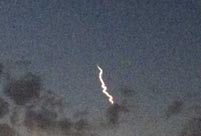

ABOARD XIANGYANGHONG 09, Feb. 3 -- China's deep sea manned submersible Jiaolong discovered a huge active "chimney vent" 20 meters tall and two meters wide in a hydrothermal area of southwestern Indian Ocean on Monday.
After finishing all planned work, the sub explored the eastern area of the working seabed and Shao Zongze, the scientist in the sub, was very excited at what he saw.
"We observed a giant active chimney vent, which was really a big surprise for our mission," Shao said. "Deep-sea chimney vents as huge as this one have rarely been seen in scientific research all over the world."
Piloting the sub, Tang Jialing videotaped the "chimney vent" and measured its height and width with a laser range finder. ( "We didn't have enough time to measure its inner temperature and to collect samples of sulfides, hydrothermal fluid and living beings this time, so I hope Jiaolong could go there again," said Shao, a researcher with the Third Institute of Oceanography of State Oceanic Administration (SOA).
There were mussels, shrimps and fishes around this "chimney vent", according to Shao.
Deep-sea "chimney vents", also known as hydrothermal sulfide, are a kind of seabed deposits containing copper, zinc and precious metals such as gold and silver. Those metals formed sulfides after chemical reactions and came to rest in the seabed in the form of "chimney vents."
Jiaolong found clues to a new active "chimney vent" on Monday north of a hydrothermal area called Dragon Flag, which was the first hydrothermal area Chinese scientists discovered in 2007, according to Shao.
Researching six hours in Dragon Flag, Jiaolong picked up the high temperature probe which the sub placed on Jan. 12 and took samples of deep-sea water, hydrothermal fluid and living beings.
"The probe recorded the temperature of a chimney vent for 21 days successfully and we will analyze all data to discover whether there is regularity," according to the scientists.
Reaching its deepest depth of 7,062 meters in the Pacific's Mariana Trench in June 2012, Jiaolong is on a 120-day expedition in southwest Indian Ocean.
 PLA soldiers operating vehicle-mounted guns in drill
PLA soldiers operating vehicle-mounted guns in drill Beauties dancing on the rings
Beauties dancing on the rings Blind carpenter in E China's Jiangxi
Blind carpenter in E China's Jiangxi Top 10 highest-paid sports teams in the world
Top 10 highest-paid sports teams in the world In photos: China's WZ-10 armed helicopters
In photos: China's WZ-10 armed helicopters UFO spotted in several places in China
UFO spotted in several places in China Certificates of land title of Qing Dynasty and Republic of China
Certificates of land title of Qing Dynasty and Republic of China  Cute young Taoist priest in Beijing
Cute young Taoist priest in Beijing New film brings Doraemon's life story to China in 3D
New film brings Doraemon's life story to China in 3D China-S.Korea FTA sets positive precedent
China-S.Korea FTA sets positive precedent Ferry carrying 458 people sinks in Yangtze River
Ferry carrying 458 people sinks in Yangtze River Mecca of Marxism
Mecca of Marxism Bring them home
Bring them homeDay|Week